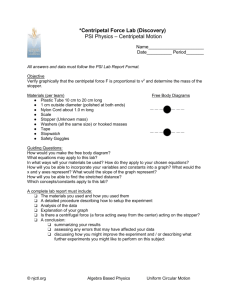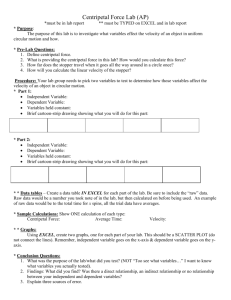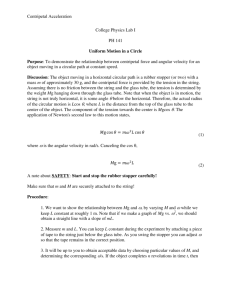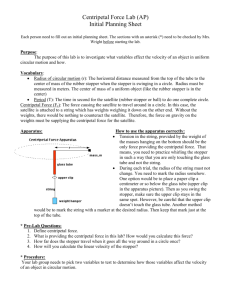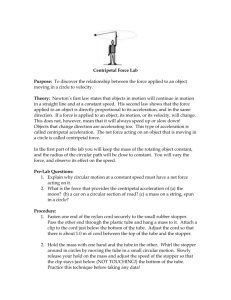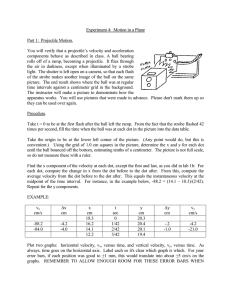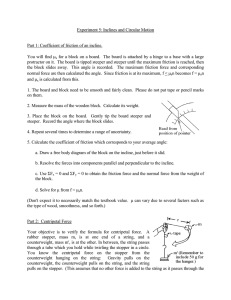R-Circular-Kinematics-Dynamics-Centripetal-Force
advertisement
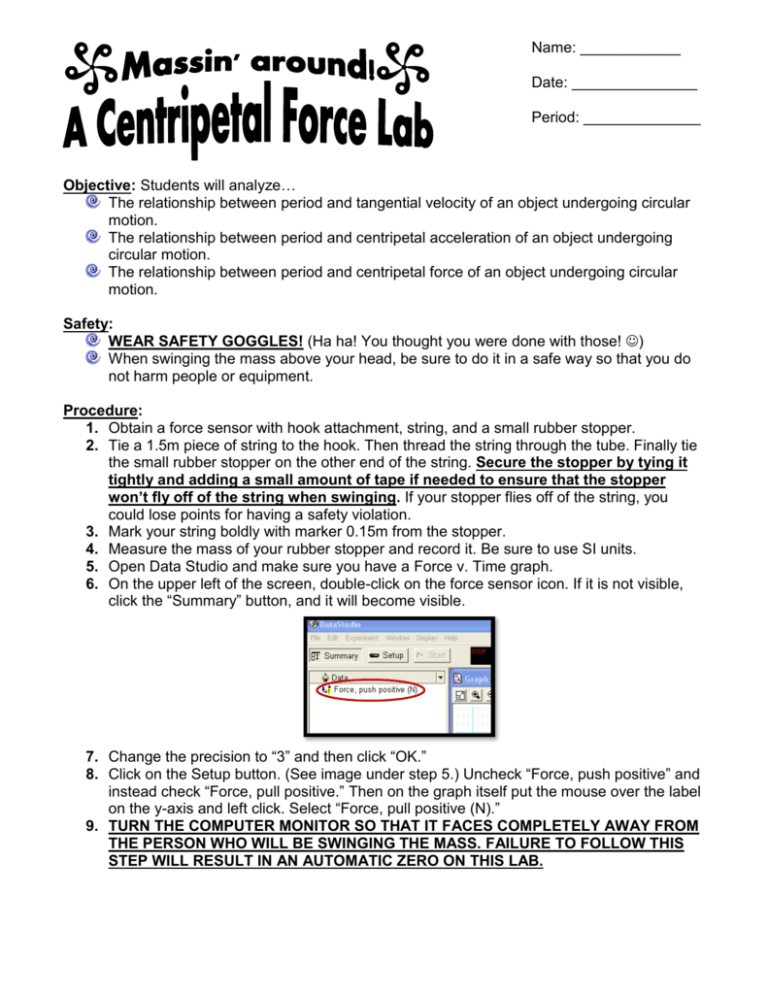
Name: ____________ Date: _______________ Period: ______________ Objective: Students will analyze… The relationship between period and tangential velocity of an object undergoing circular motion. The relationship between period and centripetal acceleration of an object undergoing circular motion. The relationship between period and centripetal force of an object undergoing circular motion. Safety: WEAR SAFETY GOGGLES! (Ha ha! You thought you were done with those! ) When swinging the mass above your head, be sure to do it in a safe way so that you do not harm people or equipment. Procedure: 1. Obtain a force sensor with hook attachment, string, and a small rubber stopper. 2. Tie a 1.5m piece of string to the hook. Then thread the string through the tube. Finally tie the small rubber stopper on the other end of the string. Secure the stopper by tying it tightly and adding a small amount of tape if needed to ensure that the stopper won’t fly off of the string when swinging. If your stopper flies off of the string, you could lose points for having a safety violation. 3. Mark your string boldly with marker 0.15m from the stopper. 4. Measure the mass of your rubber stopper and record it. Be sure to use SI units. 5. Open Data Studio and make sure you have a Force v. Time graph. 6. On the upper left of the screen, double-click on the force sensor icon. If it is not visible, click the “Summary” button, and it will become visible. 7. Change the precision to “3” and then click “OK.” 8. Click on the Setup button. (See image under step 5.) Uncheck “Force, push positive” and instead check “Force, pull positive.” Then on the graph itself put the mouse over the label on the y-axis and left click. Select “Force, pull positive (N).” 9. TURN THE COMPUTER MONITOR SO THAT IT FACES COMPLETELY AWAY FROM THE PERSON WHO WILL BE SWINGING THE MASS. FAILURE TO FOLLOW THIS STEP WILL RESULT IN AN AUTOMATIC ZERO ON THIS LAB. 10. BE SURE EVERY PERSON IN THE ROOM HAS HER/HIS GOGGLES ON BEFORE SWINGING THE MASS. FAILURE TO FOLLOW THIS STEP WILL RESULT IN AN AUTOMATIC ZERO ON THIS LAB. 11. Press “Start.” Then zero the force sensor with no tension on the string. Continue to step 12 without pressing “Stop.” 12. Spin the mass above your head by holding onto the tube. Adjust your swing and the height of the tube so that the radius is in line with the 0.15m mark. Once you are able to twirl the mass at a constant speed, start observing your data plot. After about a two dozen consistent revolutions, press stop. 13. Observe your graph. If it shows seven or more oscillations1 that are fairly consistent, continue to the next part. If not, repeat the previous steps. 14. Highlight approximately seven-to-ten consistent oscillations by highlighting from peak-to-peak. The farthest points highlighted to the left and right should be peaks. 15. Turn on the Smart Tool and move it to the first peak of the highlighted range. Then use the delta tool and drag the delta to the last peak of the highlighted range. The number along the horizontal line gives the time for that number of revolutions. Record this value. 16. Use the time from step fifteen and the number of revolutions do determine the average period for these revolutions. Record this. 17. Use the period to find the tangential velocity of the mass. Record this. 18. Use the tangential velocity to find the centripetal acceleration of the mass. Record this. 19. Use the centripetal acceleration and Newton’s second law to determine the centripetal force required to keep the mass moving in a circle. Record this. 20. Now use the Show Selected Statistics tool to show the actual average centripetal force of the highlighted range. Record this as the actual centripetal force. 21. Calculate the percent error between your calculated value and the actual (computer) value. 22. Repeat everything, but this time swing either significantly faster or significantly slower. 23. Repeat everything again with another different swinging rate. 24. Smile, for you love physics. 1 Oscilate (verb): To swing back and forth with a steady, uninterrupted rhythm Data Tables & Graphs: Recreate a similar data table in a spreadsheet to include in your lab report. You may not simply cut these out and tape them to your lab report. They must be typed and included in the electronic document. 0.15 0.15 0.15 Data Analysis: Please type out the following calculations for run 1 only in your lab report. Period Tangential Velocity Centripetal Acceleration Centripetal Force Percent Error Conclusion: Be sure to write an appropriate conclusion that addresses all objectives, supports with evidence, and accounts for errors. Comments: Be sure to make two academic comments that reflect on your learning and experience with this lab.
